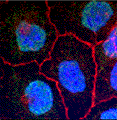Biochemistry, Department of
Document Type
Article
Date of this Version
2020
Citation
Microorganisms 2020, 8, 1515; doi:10.3390/microorganisms8101515 www.mdpi.com/journal/microorganisms
Abstract
Francisella tularensis can cause the zoonotic disease tularemia and is partitioned into subspecies due to differences in chromosomal organization and virulence. The subspecies holarctica (type B) is generally considered more clonal than the other subpopulations with moderate virulence compared to the hypervirulent A.I clade. We performed whole genome sequencing (WGS) on six type B strains isolated from the blood of patients with tularemia within a one-year period from the same United States region, to better understand the associated pathogenicity. The WGS data were compared to the prototype strain for this subspecies, specifically FSC200, which was isolated from a patient with tularemia in Europe. These findings revealed 520–528 single nucleotide polymorphisms (SNPs) between the six United States type B strains compared to FSC200, with slightly higher A+T content in the latter strain. In contrast, comparisons between the six type B isolates showed that five of the six type B isolates had only 4–22 SNPs, while one of the strains had 47–53 SNPs. Analysis of SNPs in the core genome for the six United States type B isolates and the FSC200 strain gave similar results, suggesting that some of these mutations may have been nonsynonymous, resulting in altered protein function and pathogenicity.
Included in
Biochemistry Commons, Biotechnology Commons, Other Biochemistry, Biophysics, and Structural Biology Commons



Comments
2020 by the authors